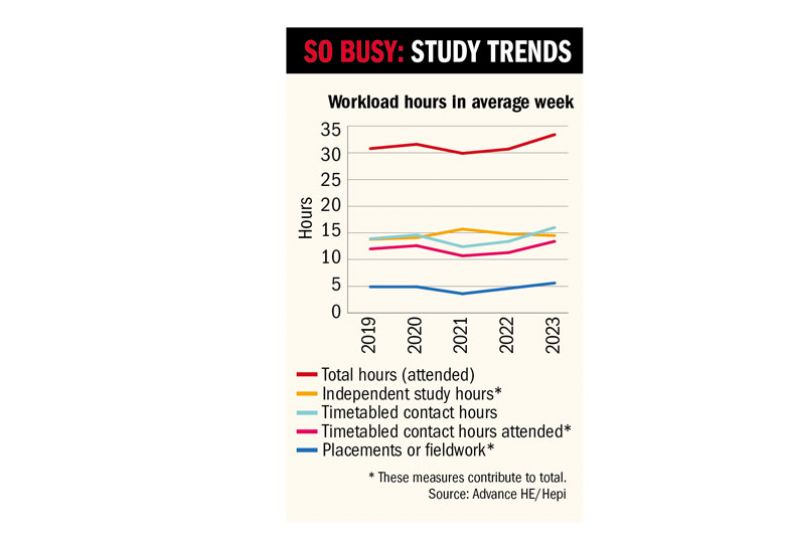UK students’ workloads have reached their highest levels in recent years, with universities increasing contact hours, assignments and placements despite more pressure on undergraduates’ time because they are having to take on paid work.
After years of complaints about there being too few seminars and lectures on some degree courses – an issue exacerbated during the pandemic – this year’s Student Academic Experience Survey, published on 22 June, identifies a rebalancing away from independent study towards instructor-led time.
Authors said this was adding to the pressure on staff and was not necessarily welcomed by all students, whose perception of value for money has not recovered to pre-Covid levels.
The annual poll of 10,000 students – run by Advance HE and the Higher Education Policy Institute (Hepi) – found that the total average number of hours spent on courses per week increased in 2023 to 33.4, after several years of remaining at around 30 or 31.

Average timetabled contact hours hit 16 per week, two and a half more than last year, with independent study down to its lowest level in recent times at 14.5.
Jonathan Neves, head of business intelligence and surveys at Advance HE, said contact hours were probably up “in reaction to the pandemic”, when students consistently highlighted that “they had not had enough or they weren’t the way they wanted, even if they understood why this needed to be the case”.
Satisfaction with contact hours increased, but the survey points out that “students who are assigned more than 30 hours a week are not quite as satisfied as those who are assigned 20-29 hours” and therefore “continued increases in the volumes of timetabled classes may eventually have a negative effect for some”.
The survey also identifies:
- A major increase in the proportion of students in paid employment, from 45 per cent to 55 per cent;
- Contact hours returning to the physical classroom, with one in four students reporting that they had no online lectures at all, compared with 11 per cent in 2022;
- Another marked increase in formative assignments, which are now at a much higher volume than in 2017.
“We’re seeing a potential issue with contact hours going up, assignments going up but also paid employment going up,” said Rose Stephenson, director of policy and advocacy at Hepi. “I think that can be quite tricky. Managing when you have to be on campus in person with other commitments is a real balance for students.”
Mr Neves said the increase in assignments in particular was getting close to a point where it was “really challenging across the board, for staff as well as students”.
He said universities had “delivered” in response to calls for more in-person learning, but there were still questions over “whether that is what all students really want now they have got it, given the other challenges they face”.
On one of the survey’s key measures, 37 per cent of students said they received good or very good value for money, an increase of two percentage points on 2022 but still below the 41 per cent score in 2019.
“If all things had been equal,” said Mr Neves, “you might have expected those key measures to go up more than they have. It looks as though cost-of-living perceptions and worries are probably holding those back.”
For the first time students who had rated their courses as poor value were asked whether long-running industrial action had affected their decisiosn. Twenty-three per cent said it had, but this was only the sixth most important factor.





